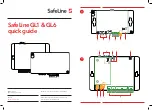
9
High Availability
165
Verifying synchronization
Once
the
slave
configuration
is
activated,
synchronization
between
the
cluster
nodes
will
take
place.
The
CLI
command
ha
will
indicate
that
both
systems
are
running
in
HA
mode
and
that
the
nodes
are
alive.
If
a
security
gateway
is
not
part
of
a
HA
cluster,
the
output
when
CLI
command
ha
is
applied
to
it
will
be:
Device:/>
ha
This
device
is
a
standalone
system
(HA
not
configured)
If
it
is
the
master
node
in
an
HA
cluster,
the
output
will
be
similar
to
the
following:
Device:/>
ha
This
device
is
a
HA
MASTER
This
device
is
currently
Active
(for
48s)
HA
cluster
peer
is
ALIVE
HA
object
sync:
100%
The
time
shown
in
parentheses
is
the
length
of
time
that
the
cluster
node
has
been
in
its
current
active
or
inactive
state.
When
the
state
changes,
this
time
counter
is
reset
to
zero.
The
HA
object
sync
percentage
indicates
whether
the
system
objects
are
fully
synchronized
between
the
peers.
Similarly,
when
the
same
CLI
command
is
applied
to
the
slave
,
the
output
could
be
something
similar
to:
Device:/>
ha
This
device
is
a
HA
SLAVE
This
device
is
currently
Inactive
(for
47s)
HA
cluster
peer
is
ALIVE
HA
object
sync:
100%
When
setting
up
HA
between
two
SEG
processor
modules
located
in
the
same
ATCA
shelf,
the
recommendation
is
to
use
the
Update
Channel
in
the
shelf
backplane
for
the
HA
Sync
connection.
To
do
this,
the
master
and
slave
modules
should
be
arranged
in
pairs
so
that
the
master
module
of
the
first
HA
cluster
and
the
slave
for
that
cluster
are
inserted
into
slots
linked
by
an
update
channel
connection.
These
slot
pairings
are
usually
indicated
by
lines
printed
on
the
ATCA
shelf
exterior.
Using
the
Update
Channel
in
this
way
frees
up
the
interface
connections
on
the
front
of
modules
for
other
purposes.
















































